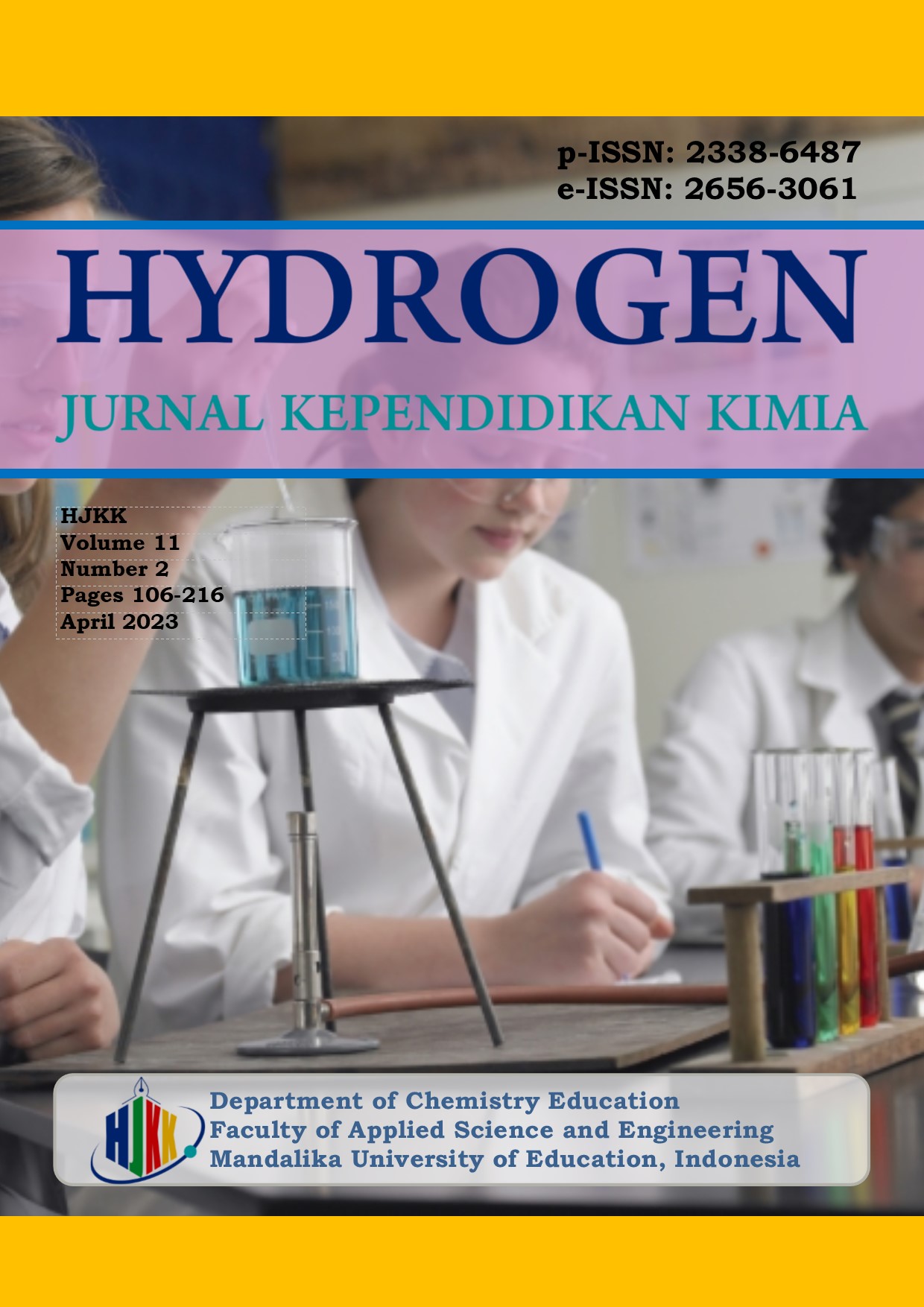Implementation of Project-Based Learning: Utilizing Natural Rocks as Waste Absorbents
DOI:
https://doi.org/10.33394/hjkk.v11i2.7423Keywords:
project base learning, zeolite, absorbentAbstract
References
Allabad, E. . (2021). Efficacy Asesment of Natural Zeolit Containing Wastewater on the Adsorption Behavior of Direct Yellow 50 from Equilibrium, Kinetics and Thermodynamic Studies. Arabian Journal of Chemistry, 14(4), 103–114.
Fitriana, N. (2019). Pembuatan Zeolit alam Teaktivasi HCl dan Karakterisasinya. UNESA Journal of Chemistry, 8(1), 17–19.
Georgiev, D., Bogdanov, B., Angelova, K., Markovska, I., & Hristov, Y. (2009). Syntesis Zeolit Structure, Classification, Current Trends in Zeolite Syntesis Review. International Science Conference, 4–5.
Karepesina, N., & Manuhutu, J. (2023). Application of Problem Based Learning (PBL) on Hydrocarbon Compound Lesson to Increase Student Learning Outcome. Hydrogen : Jurnal Kependidikan Kimia, 11(1), 51–59.
Manasikana, O. ., Khery, Y., Nufida, B. A., Ahzan, S., & Efendi, I. (2022). Respon Mahasiswa Calon Guru IPA dalam Penerapan Pembelajaran Proyek Kimia. Empiricism, 3(2), 392–398.
Manasikana, O. A., Af’idah, N., Mayasari, A., Faizah, G., Liana, M. N. T. L., & Junaidi. (2023). Scientific Learning Throught The Edu Eco Approach As An Alternatif Improving Student Knowledge and Skills. Serambi Ilmu, 24(1), 1–13.
Manasikana, O. A., Wijayadi, A. W., & Mayasari, A. (2022). Keefektifan Pembelajaran Proyek Terhadap Keaktifan dan Kreatifitas Mahasiswa Mata Kuliah Model Pembelajaran Inovatif IPA Materi Kimia SMP. Zarah, 10(1), 66–72.
Manasikana, O., Af’idah, N., Bakar, A., Andalia, N., & Safmila, Y. (2023). The Corelation Between Project Learning Models and Student Activities in Online Learning for Innovative Learning Model Courses. Prisma Sains : Jurnal Pengkajian Ilmu Dan Pembelajaran Matematika Dan IPA IKIP Mataram , 11(1), 224–231.
Mara, A., Wijaya, K., & Mudasir, W. . (2016). Effect of Sulfuric Acid Treatment and Calcination on Natural Zeolit of Indonesia. Asian Journal of Chemistry, 28(1).
Mardhatillah, Q., Copriady, J., & Futra, D. (2023). Enhancing Students Oral and Written Communication Skills Throught Discovery learning Model : A Study on reduction-Oxidation. Hydrogen: Jurnal Kependidikan Kimia, 11(1), 15–21.
Salima, N., Hairida, H., Lestari, I., Hadi, L., Masriani, M., & Ulfah, M. (2023). Analysis of Students Predicting Skills in the Concept of Reaction Rate. Hydrogen : Jurnal Kependidikan Kimia2023, 11(1), 95–105.
Sambasevam, K., Yunos, M., Rasyid, H., Bahanin, S., Suhaimi, N., Raov, M., & Shahabuddin, S. (2020). Optimization of Natural Zeolit Color Extraction of Dragon Fruit. Scientific Research Journal, 17(2), 33–44.
Taufiq, A., Teraningtyas, A., Kusumawati, D. ., & Supardi, Z. A. I. (2022). Nanosized Fe3O4 SiO2 Chore Shell FabricatedFrom Natural Sand Magnetic Properties and Aplicatoion for Die Adsorption. Enginering and Applied Science NanosiResearch, 49(3), 340–352.
Widiyanti, S., & Dyah, R. (2021). Efektifitas Pembelajaran Berbasis Proyek Terhadap Kreativitas Mahasiswa di Pandemi Covid 19. Journal IT CIDA, 7(1), 35–47.
Downloads
Published
How to Cite
Issue
Section
Citation Check
License
License and Publishing Agreement
In submitting the manuscript to the journal, the authors certify that:
- They are authorized by their co-authors to enter into these arrangements.
- The work described has not been formally published before, except in the form of an abstract or as part of a published lecture, review, thesis, or overlay journal.
- That it is not under consideration for publication elsewhere,
- That its publication has been approved by all the author(s) and by the responsible authorities – tacitly or explicitly – of the institutes where the work has been carried out.
- They secure the right to reproduce any material that has already been published or copyrighted elsewhere.
- They agree to the following license and publishing agreement.
Copyright
Authors who publish with Hydrogen: Jurnal Kependidikan Kimia agree to the following terms:
- Authors retain copyright and grant the journal right of first publication with the work simultaneously licensed under a Creative Commons Attribution License (CC BY-SA 4.0) that allows others to share the work with an acknowledgment of the work's authorship and initial publication in this journal.Â
- Authors are able to enter into separate, additional contractual arrangements for the non-exclusive distribution of the journal's published version of the work (e.g., post it to an institutional repository or publish it in a book), with an acknowledgment of its initial publication in this journal.
- Authors are permitted and encouraged to post their work online (e.g., in institutional repositories or on their website) prior to and during the submission process, as it can lead to productive exchanges, as well as earlier and greater citation of published work.
Licensing for Data Publication
Hydrogen: Jurnal Kependidikan Kimia uses a variety of waivers and licenses, that are specifically designed for and appropriate for the treatment of data: Open Data Commons Attribution License, http://www.opendatacommons.org/licenses/by/1.0/ (default) Other data publishing licenses may be allowed as exceptions (subject to approval by the editor on a case-by-case basis) and should be justified with a written statement from the author, which will be published with the article.







